chapter four
Friendship
“Nobody sees a flower really; it is so small. We haven’t time, and to see takes time — Like to have a friend takes time.”
Georgia O’Keeffe
Taking a Chance and Making a Friend
People who are optimistic take more chances, and the more chances you take, the more good things happen. Like most people, I would say the best things in my life have happened when I put myself out there and made myself a little vulnerable. That’s how I met my friend Brigid.
At seventeen, my parents let me fly alone to Memphis, Tennessee to attend a prospective student weekend at Rhodes College. I was beyond excited. I showed up in Memphis wearing a navy blazer, gold add-a-bead necklace, monogrammed crew neck sweater, madras plaid pants, Bass Weejuns, and one of those monogrammed purses with the interchangeable covers you could match with your outfit. I had even color-coordinated the striped grosgrain band on my tank watch. It was 1981 and The Preppy Handbook was my style bible. I was determined to land in Memphis not looking like who I really was—a small girl from a small town, eager but secretly scared.
When I arrived at Rhodes, I was awestruck by the beauty of the campus. Its gorgeous stone buildings, gothic towers, and oak-lined lawns were a postcard of what college should look like. Watching all the fresh-faced students as they laughed and talked on their way to class, I knew immediately that I wanted to fit right in.
At the check-in desk, a counselor gave me an information folder and introduced me to the student host I would be staying with, waving over a girl with waist length hair, a flowy, bohemian dress, and some kind of half-combat boot, half-fisherman sandal on her feet. She had painted her fingernails matte black.
Around me swirled the sorority girls and their prospective students, laughing and making plans to attend the football tailgate the next afternoon. My student host was kind and polite and, looking back, more indulgent of my over-the-top outfit than I was of hers, but I was disappointed.
She lived in the foreign-language dorm. Her room was filled with plants, guitars, and hand-thrown pottery. She was an art major who spoke several languages. I met her roommate, who played the harp, and a few other girls, none of whom knew or cared anything about the football tail-gate or the fraternity parties going on that night. Two of them were conversing in Italian. In a few years, my twenty-year-old self would know that these girls were very cool, but my seventeen-year-old, plaid-pant-wearing self was desperate to get out of there and meet the Chi Omegas, Tri Deltas, and cute SAEs.
When she dropped me off in the main hall for the Prospective Student information session, I looked longingly at the other girls, who all seemed to be ensconced in lively, chatty groups of twos and threes. I felt lonely and, worse than that, embarrassed to be alone, the way you do in large crowds, especially at seventeen.
I sat miserably for a while, until I realized the only way I was going to have someone to talk to would be to make the first move and actually talk to someone. I forced a smile and broke into the conversation to my right. At first the girls were aloof, but the one next to me was actually quite friendly once the ice was broken. We whispered through the boring Dean of Students’ lecture, but once it was over, she picked up her sweater and turned to leave with her friend. “Nice to meet you!” she trilled over her shoulder. My heart sank.
“Umm… what are y’all doing for dinner?” I asked, humiliated to be so pushy but also fiercely determined not to go back to the Foreign Language Dorm for the evening harp concert. “We have plans with our boyfriends,” the not-so-nice one said briskly. (They had boyfriends here already? My humiliation was complete!)
But the girl I had so determinedly chatted with took pity on me. “Yes, we’re meeting them right now,” she said. “But there are a bunch of girls here from Little Rock back in our dorm. I got to know one of them, Brigid, this morning. She’s really fun. I think they’re going out to dinner at Overton Square. If you want to follow us back to the dorm, I’ll introduce you.” I grabbed this lifeline with both hands and trailed behind them like an unwanted puppy, eager to meet these “fun” girls and hoping they would let me tag along.
And that’s how I met Brigid. The introduction was ignominious, to say the least. My other new “friend” was painfully obvious in her eagerness to dump me and get on with her evening. She literally pushed me forward, saying flatly, “This is Kelley. She doesn’t have anyone to go out with tonight. Can she go with you guys?” I was mortified, feeling like the oddball cousin your mom insists be “included.”
Brigid, confident looking and beautiful with her big dark eyes, had been laughing with all her friends from Little Rock until I was abruptly foisted on her. They all went quiet as I was appraised. Brigid paused an agonizing second or two, clearly trying to think of a polite rejection since I was so ridiculously prepped out (they were all rather more restrained in their use of madras and monograms), but then she smiled and gave me a rather unsure, “Sure!” I was swamped with relief. I knew they would like me if they gave me a chance!
I had a ball that night. Brigid was cool and irreverent without being pretentious or snobby, and I liked her immediately. She regaled me with funny stories of her horrible ex-boyfriend and summer job at Godfather’s Pizza. We both loved to read, planned to major in English, and were obsessed with The Go-Go’s and The Police. (Brigid would start a new wave band, Brigid and the Neutrons, our freshman year. Margaret and I were her backup singers—although I have some suspicion that my mic was turned off after the first rehearsal.)
We couldn’t wait to start our big college adventure, filled not just with the obligatory great learning and preparation for exciting, high paying careers, but lots of parties with all the cute boys roaming that campus. For me, college began that night, even though its official start was nearly nine months away. I had made the first move, and it was awkward and embarrassing, like a lot of first steps, but it was worth it. I had made a friend. Is there anything sweeter?
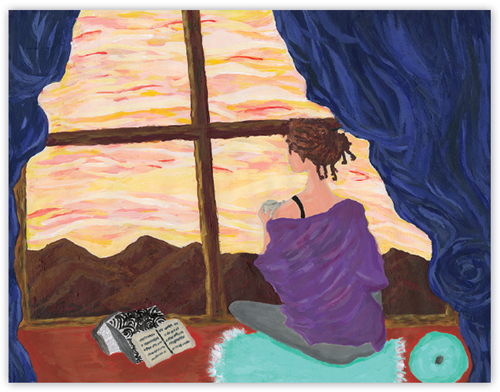
KC
Brigid once wrote me a letter that she closed with the sentence, “Thank you, my true and constant friend.” It made me feel deeply happy to know that I had been that to her, and I have never forgotten those beautiful words.
Brigid is my free spirit friend, a dreamer and a seeker. Raised in a staunch Catholic household, she is now a practicing Buddhist, and writes a thoughtful, funny, wonderful blog called, “Adventures of a Southern Buddhist Catholic.” Her spirituality has always reminded me of this quote from one of my favorite books from my college days, Walker Percy’s The Moviegoer:
“What do you seek—God? You ask with a smile. I hesitate to answer, since all other Americans have settled the matter for themselves and to give such an answer would amount to setting myself a goal which everyone else has reached— and therefore raising a question in which no one has the slightest interest. Who wants to be dead last among one hundred and eighty million Americans? For, as everyone knows, the polls report that 98% of Americans believe in God and the remaining 2% are atheists and agnostics – which leaves not a single percentage point for a seeker.”
Like me, Brigid was an English major at Rhodes. She has made a career as a writer and editor, and was Director of Advertising at Turner Network Television before walking away from the corporate world and driving alone to Mexico in her ancient BMW 320i, in order to devote herself fully to writing and contemplating her next life move.
We are an odd match in a way. I am more conservative and risk-averse by nature (some would say conventional!) and I worried about her during that time. She came away from that experience knowing that she no longer wanted to work for a big corporate entity—that she wanted, as she writes on her blog, “to focus on words, and living a happy life.”
When I asked my friends to tell me personal stories of the women in their lives for this book, I was disappointed when Brigid didn’t share one at our reunion. She later admitted to me that she was daunted by the request, which surprised me as she makes her living as a freelance writer. “I listened to the stories and memories you each shared,” she said, “and I felt sad and regretful that I had never really connected with my mother or a grandmother the way so many of you have.”
A few weeks later she sent me the beautiful essay on the following page. “I’m grateful now that you came up with this idea,” she wrote, “because it really helped me to examine and come to terms with so much about my mother and our relationship.” Her story, “Are You My Mother?” reveals that we don’t always understand life’s lessons while we are learning them, and that one of the great blessings of time is the ability to see with older eyes.
Are You My Mother?
Brigid’s Story
One warm summer morning after my mother left for work, I slipped into her bedroom and opened the bottom drawer of her dresser. Carefully pushing aside the garter belt and girdle and silk stockings, I foraged for a book entitled, Am I Becoming A Woman? I was ten years old and although I didn’t understand what was inside the pages of that book, I had a feeling it contained secrets that I needed to know. I caught a glimpse of its cover once when I borrowed my Mom’s brocade purse to play dress up. She kept the lovely evening bag wrapped in plastic in that drawer. With its little gold clasp and a gold chain handle, its very presence fascinated me. When did my practical mother ever have use for such a thing? Not once had I seen her put on garters and silk stockings and carry her little evening bag out for a night on the town.
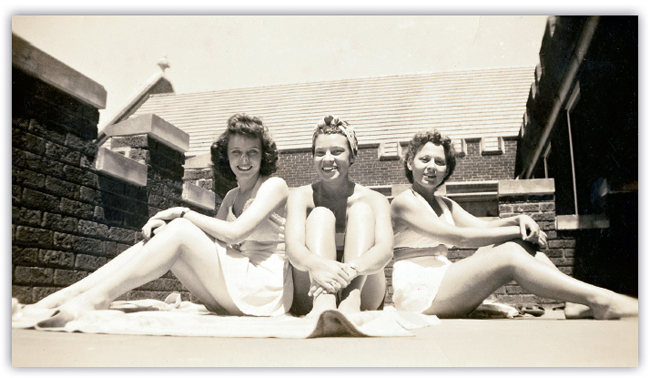
Beneath the purse was the book but there was also another plastic bag. This one contained four birth certificates. Mine was on the top. My name was spelled in calligraphy: Bridget. Not Brigid, which is how I always spelled my name. Odd. I read on and saw that my mother was forty-three when I was born. Since I was ten, that would make her fifty-three, ancient by my reckoning. I never thought of my mother as an age before then, but afterward I noticed that she’d say things such as, “I don’t like how my legs look in shorts,” or “Don’t take my photo now, I’m not wearing makeup.” At the time I thought she was just being silly. I thought my mother was beautiful. I didn’t care if she had spidery varicose veins. I just wanted her to come swimming with me. I didn’t see the lines that time scribed into her face. I only wanted her to sit with me and tell me stories. Now, as I find myself nearing the same age, I realize what she meant—and it makes me sad that I didn’t know her.
I never really knew my mother. At least I didn’t know much about her. She was a quiet woman who didn’t speak of her past. And yet, I know she had another life, long before I was born.
Mom attended Saint Anthony’s School of Nursing in Oklahoma City from 1944 to 1948. She received her RN and worked in the operating room. I know this because she sometimes spoke of her time in surgery, which amazed me that my gentle mother could withstand the sight of blood and gore. After she passed away, I found a box she kept in her closet filled with small 2'' x 4'' black-and-white photos, a collection of funny, old postcards and letters from her mother, my grandmother, who died when I was just three years old.
The little black-and-white photos provided clues about who my mother once was. In these images a young woman smoked cigarettes, traveled to New York City with her girlfriends, studied on her twin bed in a dorm room and wore fashionable suits with shoulder pads as thick and sturdy as a linebacker’s, her lips painted slick and red.
There are dozens of images of Mom with her best friend Margaret Ann Brown and other girls identified as Diane, Isabel, Loretta and Rita. Their names are scrawled in my mother’s scratchy script on the backs of some of these images. They are smiling girls who pose in modest swimsuits, stylish dresses, and starched white nursing uniforms, complete with black capes. And there’s Mom’s graduation portrait, depicting a beautiful young woman with perfect, smooth skin and deep brown eyes, dark as onyx marbles. Her face was fuller and rounder than I recall, her dark curls to her shoulders and her smart nursing cap affixed like a halo above her head.
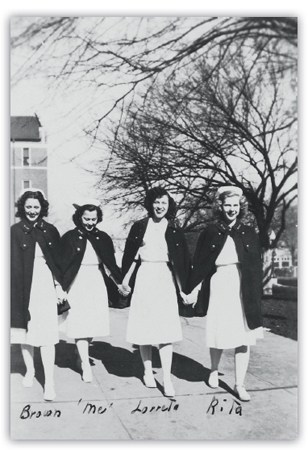
Was she as virtuous as she appeared? She was attractive and—judging by the photos— outgoing and friendly, so surely she must have had beaus before she met my Dad in 1949. But to hear her tell the tale, “There was no one special.” I suspect that No One Special broke her heart along the way. If so, she never gave him a name.
In another box on the shelf were letters about Nick, my mother’s twin brother who disappeared in World War II. He was an airplane mechanic in the Army Air Corps, assigned to cargo planes flying over The Hump across the high, Himalayan Mountains. At the end of the war, his plane crashed and neither it nor the crew were ever found. Letters and copies of letters from Nick before he disappeared, telegrams from the War Department, and sepia news clippings about other similar incidents were tucked away in that box.
From time to time, one of my sisters or I would become curious and retrieve the box from the closet and go through it as though it were a puzzle filled with jigsaw pieces. We would empty out the contents and sift through the clues. We thought if we pondered over the evidence long enough, a clear picture might form of what happened to the uncle we never knew.
I believe my mother held out hope throughout her life that he was still alive. “I still just can’t believe it,” she told me one night as we drove home from a family gathering. “I still can’t believe he’s gone.” The war had taken its toll on her; it extracted a great price.
I never knew my mother. I wove her legend from expressions in black-and-white photos, from her quiet responses and from scraps of history tucked away in cardboard boxes kept high on her closet shelves. I stitched her story together from scraps that fell from her lips on rare occasions when she spoke of the life she led before she became my Mom.
As I entered puberty, our relationship began to stretch thin in the typical tug-of-war between mothers who want to protect and daughters who want to be free. But we found a common ground in fashion. Although most of my wardrobe came from J.C. Penney or Sears or my sisters’ hand-me-downs, sometimes I’d wander into M.M. Cohn, the upscale department store in town, and find a dress or skirt I liked.
Sometimes my mother would assess the garment and its price tag and whisper, “We can make that for so much less,” as if the clerk might overhear our scheme to copy the design.
Then she’d send me to the dressing room to try on the coveted item. She’d fish out a deposit slip or grocery receipt and a pencil from her purse and sketch the garment as I modeled it, turning this way and that before the three-way mirror, admiring the cut of the skirt or the softness of the chintz.
“Stand still so I can see how it’s made!” she’d say.
I would wait for her to finish her assessment. Then we’d retreat to Hancock’s fabric store to find the necessary items.
My favorite time with Mom was spent inhaling the starchy perfume in the rows of fabric bolts. Perched on a hard stool near the front of the store, I poured over pattern catalogs until I found a Simplicity design that was close in style to the dress I coveted. Mom would peer over my shoulder and nod, or suggest a modification or two.
Late in the evenings, after dinner dishes were left drying beside the sink and crumbs had been swept from the floor, my job was to carefully cut out the tissue paper pattern. Spreading the fabric out on the floor, Mom knelt and pinned the thin, brown papers onto the cloth. While she pinned and cut, I sat nearby running my fingers through the collections of buttons she kept in an old oatmeal canister. Nothing went to waste.
I tried my hand at sewing in a high school home economics class but found the work tedious and confusing. Although I managed to stitch together an A-line skirt, most of my projects ended up in my mother’s scrap bag.
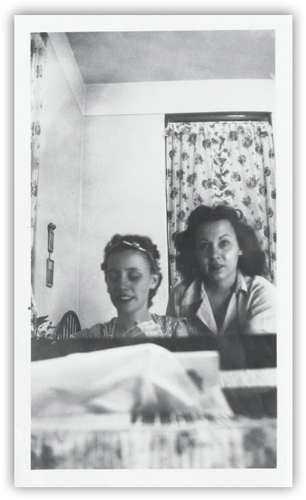
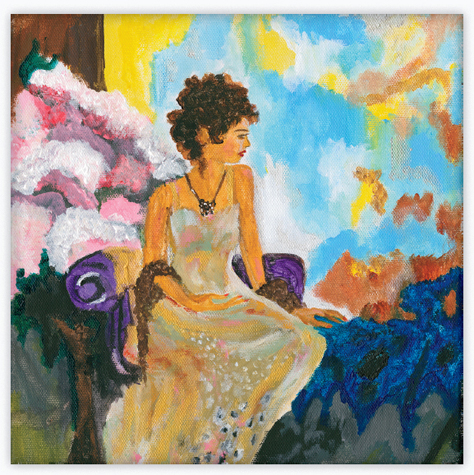
As I edged toward college, our differences became more apparent—or so I felt. By this time Mom was sixty-one and I was eighteen and the gap between us widened, but we still came together over patterns and fabric and notions as she sewed up the prom dresses I designed. My senior year, I wanted a sexy, strapless green velvet gown with a straight skirt and a slit up the side to my thigh, and she created it. Tailor-made and of my design, it was a perfect fit. But I wonder now how she felt as I primped before the mirror, tugging up the bodice to hide what little cleavage I had and smoothing the velvet skirt over my hips. She let me go to the dance that night wearing that sexy dress and four-inch heels and too much eye makeup. She never did talk to me about sex. I suppose she thought I’d figured it out by that time. But I hadn’t. Not really.
I wanted my mother to be someone she wasn’t. I wanted a TV sitcom mom like the ones on the shows I watched every week. I wanted a mom who could sit lightly on the corner of my flower-power comforter, smooth my soft, blonde hair (I’m a brunette), listen intently to my sorrows, and find the exact, scripted words to soothe all my insecurities and make me feel good. My self-centered teenage heart could not see that Mom conveyed her love by the late-night hum of her sewing machine.
I wanted a mother who would be my conspirator. I wanted a mother who could teach me what it meant to be sexy and strong. And last but not least, I needed a role model to help me understand what it meant to be a mother when my turn came along. I received it all.
Were there days when my mother looked at me and wondered who I was? Or did she recognize herself in me? Did I inherit her longing for better things in life? Did she pass her love of travel to me? Did she inspire the deep and abiding friendships I have with so many women today?
Only after she died of dementia at age eighty-nine did I begin to realize that I had been granted the mother I needed. And what my mother could not impart to me was provided by many other “mothers” along the way who have lent me their guidance and love.
Throughout my life I’ve been given wonderful friends to share the giddy moments and help me through the most difficult times. I have three sisters, whom I admire, love and hold dear, and yet, I’ve turned to my girlfriends again and again for understanding when my life is at its best and worst. I rather think of them as the family of my choosing, and my other mothers.
I never really knew my mother, but looking at those old photos, I can see myself. I am like her, peering out with large, dark eyes at the world, arms linked with my friends, standing coyly on the edge of whatever comes next.